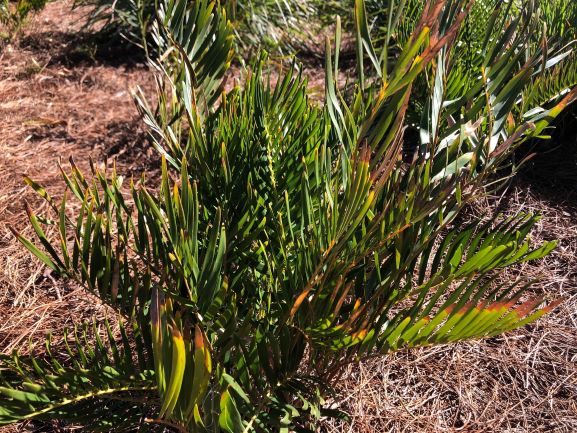
by Carrie Stevenson | Mar 11, 2021
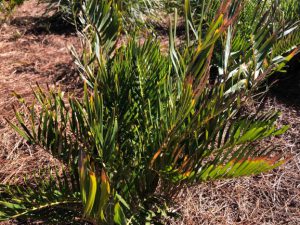
The ancient cycad, coontie, is a hardy and attractive plant for Florida landscapes. Photo credit: Carrie Stevenson, UF IFAS Extension
The plant has a crazy-sounding name, more like some little animal you’d find in Australia than a native plant. However, an ancient Florida plant it is, and a tough one at that. Growing close to the ground, it most resembles a large fern or a sago palm, if the sago had smooth, rounded leaf edges. Like the sago, the coontie (Zamia floridana) is a cycad—a group of palmlike plants that have been around so long that triceratops and stegasauruses ate them! Coonties are the only cycads native to North America, found in the states and island nations like Cuba and the Bahamas.
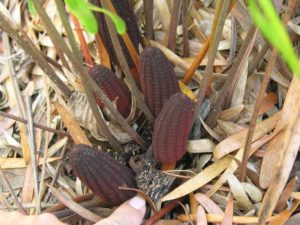
Male cones (strobilus) of coontie are thinner and shorter than female cones. Photo credit: Dan Culbert, UF IFAS
Another interesting feature of the coontie is its seed cones. These are large reddish orange cones that resemble magnolia seedpods. Both sexes of plant produce them in clusters ranging from one to five of the 2-7” long cones. Cones from the male produce pollen, while females produce seeds. If you are interested in attracting wildlife to your yard, the coontie provides good low-growing cover for birds and small mammals. It is also the preferred food for the caterpillar of the rare Atala butterfly. Members of the Timucuan and Calusa tribes ground up the starchy root of the coontie as a flour. However, the root contains a toxin and if it is not removed first, ingestion could result in severe abdominal pain and vomiting. From the late 1880’s through World War I, a large starch industry existed in Florida, producing flour from the coontie root.
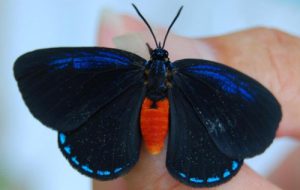
Adult female atala butterfly, showing royal blue streak on forewings. Photo credit: Sandy Koi, University of Florida
At home in drier soil conditions like oak hammocks and pinelands in north central Florida, these plants can also adapt to a variety of soil pH types. Coonties are drought, cold, and salt tolerant, thus a great landscape choice for coastal landscapes near the Gulf or a bay. The plants are very long-lived and adaptable. In fact, the book Florida’s Best Native Landscape Plants notes it is “Very hardy and easy to care for. Will grow well in any part of Florida, even outside its normal range. An exceptional replacement for the closely related, often used, but non-native sago palm.” In other words, this is an ideal landscape plant that should be used more throughout Florida.
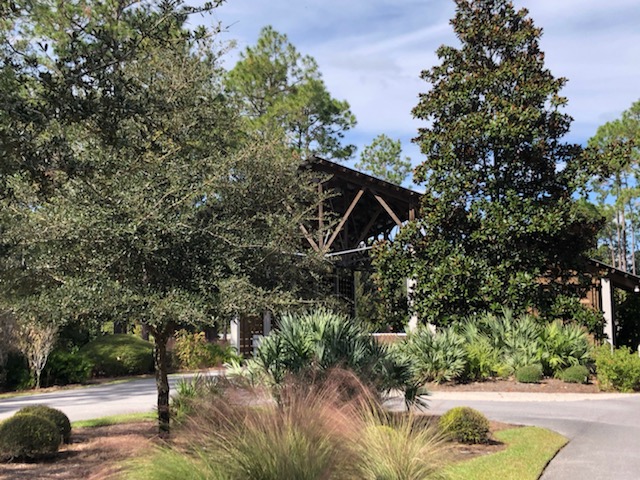
by Stephen Greer | Mar 11, 2021
Landscaping with native plants brings opportunities and challenges while adding diversity and beauty to the home. There are many factors that come into play to successfully grow plants. As gardeners, we all want things to look exceptional for all to enjoy. Native plants have evolved over long periods of time naturally in a given region without intervention, bringing much needed diversity to natural areas and landscapes. A big plus for natives are the flowers presented for the local bee populations and other pollinators assisting in the continuation of the plant species potentially established over thousands of years.
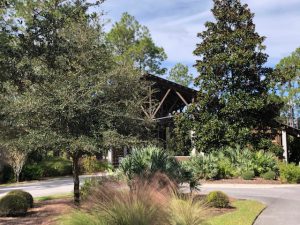
Landscape of Native Plants. Photo Credit: Stephen Greer, UF IFAS Extension Santa Rosa County
Native plants have evolved in natural communities and are found to be interdependent not only plant to plant yet with soil type, soil microbial activity through bacteria and fungus, specific site location and others though biodiversity of these living communities. Part of this community is often referred to as the soil web creating the connections of billions upon billions of organisms in the critical survival of the plants, insects and other animals we see. The first steps when considering native plants for your landscape are to do your research and contact your local Extension office. Some questions to consider may include: Does it grow best in well drained sand or wet soils or require high in organic matter? Will full sun, part-shade to full shade be needed?
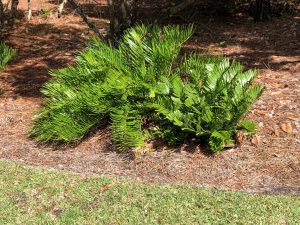
Coontie Palm in Landscape. Photo Credit: Stephen Greer, UF IFAS Extension Santa Rosa
Plants that are native and non-native are often seen in the same landscape setting. Consideration should be taken to determine if either of the groups are aggressive in expanding beyond the intended plant setting. Before moving on, non-native is in reference to plants that are introduced to a plant community that came from a totally different plant location. An example of that location being hollies from southeast Asia or South America or even a different area of the United States. Many have been researched and observed for many years under managed situations before being introduced into the local landscape nursery markets. Once in a while a plant is introduced that has not gone through a long rigorous study and can become naturalized outside of its normal plant zones and establish as an invasive species. This highly adaptable aggressive habit can, and often will colonize a given location out competing the native plants. Kudzu is a good example of an invasive exotic plant that is naturalized in the southeastern U.S.
As gardeners there are opportunities to have positive impacts on some of these diminished native habitat areas that can be threatened by growth of urban and rural areas in Florida. Establishing native plants areas into the landscape with proper soil preparation, managed water needs and more gives that chance for this interdependent system of plants, animals and nonliving elements to remain established with big impacts.
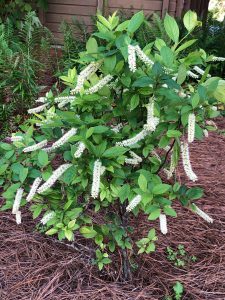
Virginia Sweetspire. Photo Credit: Stephen Greer, UF IFAS Extension Santa Rosa County
Native plants can be a working part of the garden from wonderful flowers, season color change, leaf foliage of multiple sizes and shapes to feed the insects that feed the birds, leaves and nuts that feed so many other animals for us to enjoy seeing. Balance is such a big part of being a successful gardener. Remember not all native plants are suitable for landscape spaces, do your research and ask for assistance from the experts to determine if it is the right plant for the right place.
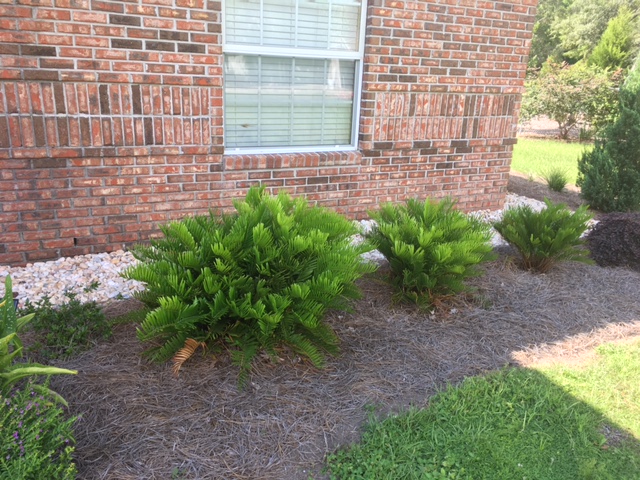
by Julie McConnell | Jul 12, 2017
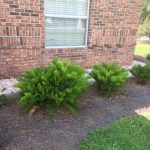
Coontie (Zamia floridana) planted at the same time but growing at different rates. Photo: J_McConnell, UF/IFAS
When designing landscapes, it is popular to create lines and masses of plants for high visual impacts. Plants are carefully selected to be similar in size and shape at the time of installation. They are all grouped together, so they must be getting the same care, but why do they look different years later? There are several factors to consider when we are trying to figure out why a perfectly matched set no longer looks like a uniform planting.
Although plants may be in the same bed, shadows cast at certain times of the day may reduce sunlight to some sections and not others. This can be caused by structures or trees that have grown over time and changed light patterns.
Supplemental irrigation may also be variable even with the best system design. Over time plants grow and may block sprinkler emitters from reaching some sections of landscape beds. Even if the landscape relies on natural rainfall, there can be still be dry/wet spots in the landscape due to drainage off of hard structures, low areas, or wind direction during storms.
It might be possible to adjust some lighting and watering issues, but there is one factor that many gardeners have not considered – genetics. If plants were grown from seed, than variation is not only possible, but likely. This might be displayed as differences in height and width, foliage color, flower color, speed of growth – all may be influenced by parentage despite best efforts to care for each plant similarly.
Many landscape plants are cultivars. This means they are grown from cuttings or divisions which make them identical to the original plant. When a plant is grown from seed, however, there is no guarantee it will have the same specific qualities as the mother plant.
To combat this phenomenon, landscapers should check sunlight and watering for irregular growth patterns and adjust if needed. If a landscape design requires uniform plants, use named cultivars rather than seedling grown plants in lines or masses.










